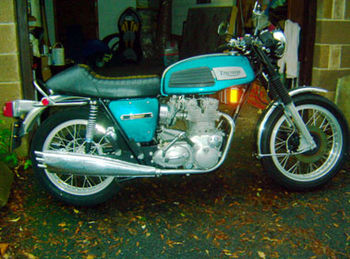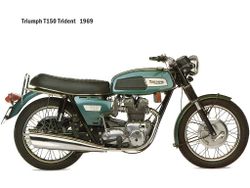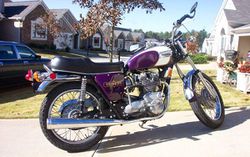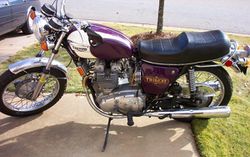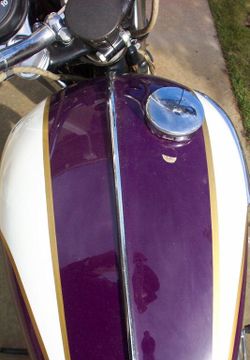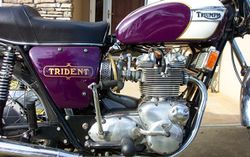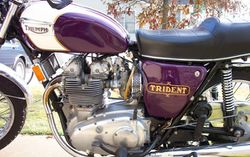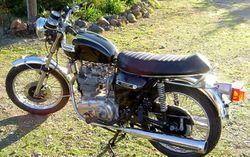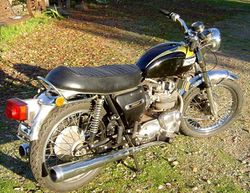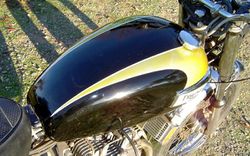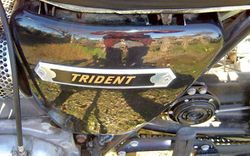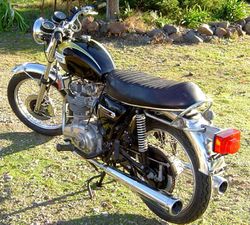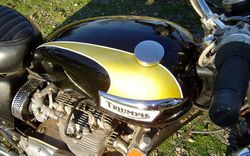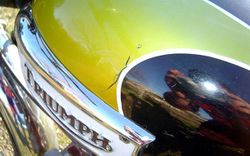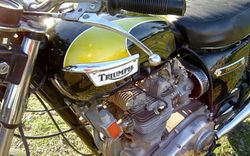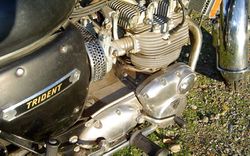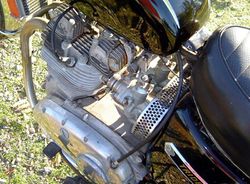Triumph Trident T150
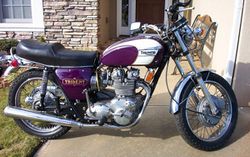 |
|
| Triumph Trident T150 | |
| Manufacturer | |
|---|---|
| Engine | |
| Bore / Stroke | 67.0 x 70.0 mm |
| Compression ratio | 8.3:1 |
| Top Speed | 120 mph |
| Horsepower | 60.00 HP (43.8 kW)) @ 7250 RPM |
| Spark Plug | NGK DPR8EA9 `91-98[1] |
| Transmission | 5-speed |
| Final Drive | Chain: 530 `91-98[1] |
| Front Tire | 120/70-17 `91-98[1] |
| Rear Tire | 160/60-18 `91-98[1] |
| Weight | |
| Related | BSA Rocket 3 Triumph X75 Hurricane |
| Competition | Honda CB750K Suzuki GT750 Kawasaki H2 |
| Manuals | Service Manual |
The Triumph Trident T150 is a 750cc, triple cylinder, four stroke, street motorcycle manufactured by Triumph from 1969 through 1975.
The BSA version of the bike was the BSA Rocket 3.
Triumph revised the T150 Trident for the 1971 model season. The mechanical components benefited from minor revisions, but the appearance of the model was considerably altered, losing the "heavy" styling of the earlier machines and adopting a style which reflected the twin cylinder Triumphs of the period. The side panels were changed as was the exhaust system, which adopted tapering, megaphone style silencers. New blade type mudguards and slimline forks were adopted and indicators were fitted. The model continued in this form until 1972 when a five speed gearbox and a 10 inch front disc brake were fitted, the T150V, as the model was now typed continued unaltered until 1975 and the introduction of the considerably revised T160.
1969 TRIUMPH T150 (BSA A75) Specification. Article stolen from Classic Bike[edit | edit source]
Type - air-cooled ohv triple
Capacity - 741cc
bore x stroke - 67 x 70mm
compression ratio - 9.5:1
lubrication - dry sump
carburetion - 3 x 26mm Amal Concentrics
primary/final drive - chain/chain
clutch/gearbox - dry single plate/four-speed
electrics - 12 volts
ignition - coil
Frame - single downtube brazed and bolted (duplex cradle welded)
front suspension - telescopic forks
rear suspension - swingarm, twin shocks
brakes - front/rear 8in tls drum/7in sls drum
wheels - wire spoke/steel rims
tires - front/rear 3.25 x 19in Dunlop K70 /4.10 x 19in Dunlop K81
dry weight - 468lb/212kg (470lb/213kg)
seat height - 31in/787mm (32in/813mm)
wheelbase - 58in/1473mm (561⁄4in/1429mm)
fuel capacity - 41⁄4 gallons/19 liters
top speed - 129mph
standing 1⁄4 mile - 13.4 seconds @ 105.5mph
power output - 58bhp @ 7250rpm
fuel consumption - 32-45mpg
The Engine. All material shamelessly stolen from Classic Bike magazine[edit | edit source]
Here's some more stuff that's been stolen from Classic Bike magazine. Copyright be damned. Engine design genius Doug Hele first conceived of a triple while working for Norton in the early 1960s. His engineer’s experience told him that a triple might be one way round the problem of vibration that dogged the parallel twins. It seemed to Hele that a three cylinder engine with the crankpins evenly spaced 120 degrees apart would have perfect primary balance.
He discussed the idea with his friend Bert Hopwood who, at the time, was general manager with Triumph. Hele knew that Norton wouldn’t be able to afford to embark on a triple project, and its move South to Plumstead towards the end of 1962 was his cue to accept a job offer from Hopwood at Triumph. Early in 1963 the two men drew up plans for a prototype triple.
Hopwood and Hele wanted the engine to be narrow in trademark British style, keeping its weight centralised. They borrowed the bore and stroke of 63 x 80mm from Triumph’s pre-unit 500 twins for the Project One (P1) triple prototype. This possibly gives rise to the pub drone’s assertion that the Trident is simply a ‘Tiger 100-and-a-half’. Production dimensions were 67 x 70mm, the same as the BSA C15 250 single. It was a nod to modular construction methods favoured by Hopwood.
The team decided the existing T120 gearbox was adequate for the 750 three. They found that the gap created between the wider engine and the narrow box could be filled by the clutch – a pushrod operated multiplate unit for the prototype, and a pullrod operated single plate Borg & Beck type for the P2 and production.
The first prototype taught them that the different rates of heat dissipation between aluminum and iron ruled out conventional iron barrels. They tried iron lined alloy barrels on the P2, but eventually arrived at austenitic steel liners in alloy barrels. The larger bore of the C15 dimensions from the P2 allowed for larger valves to be used for better gas flow. The rocker boxes were high on the head to isolate them from the heat of the combustion chambers.
Better materials cured the early failures of theplain main bearing. The P1’s gear primary drive was replace by a triplex chain set-up. They also abandoned an adapted Bedford van distributor which had been tried behind the barrels for ignition and the oil pump deep in the crankcase.
Ignition was eventually triggered by three contact breakers on the end of the exhaust cam and the oil pump relocated to the primary case. An oil cooler was plumbed in too.
The team used chopped Amal Monoblocs on the P1, and Concentrics were available by the time the P2 was being developed. Production bikes used 26mm units bored out to 27mm.
Model years. Yes, this bit is ripped off too[edit | edit source]
1969 Triumph Trident and BSA Rocket 3 introduced. Raygun silencers; steel slider forks with external springs; full-width tls front brake; ‘breadbin’ tanks.
1970 Trident ‘Beauty Kit’ introduced to counter American resistance to the slabby styling. Kit included a rounded tank; Bonnevillet ype seat; revised side panels and mudguards; barrel silencers.
1971 Both models revised. Changes include conical brakes; megaphone silencers; alloy slider forks with internal springs and exposed stanchions; optional five speed gearbox; revised styling for both models includes revised side panels and wire headlamp and mudguard stays; chromed mudguards. Export models get smaller tanks, partially chromed on BSA. From July 1972 T150 becomes T150V with standard fitment of five speed box. Rocket 3 renamed Three.
1973 Long cigar type silencers replace megaphone type; 10in front disc brake; revised headlight carried in pressed steel brackets; square type rear lamp introduced. BSA/Triumph group collapse. NortonVilliersTriumph continues Trident production, but the Rocket Three is axed.
1973 Hurricane The Craig Vetter styled Triumph X75 Hurricane was the most stylish factory custom ever made. Despite the Triumph badge, the engine and frame were based on actually BSA Rocket Three components. The glassfibre tank/seat covered a tiny two gallon tank, the forks were raised and the gearing was lowered. The Hurricane’s most distinctive feature was its three into three exhaust system.
1974 Air filter becomes enclosed rather than mesh type and now has two intake hoses to comply with Federal regs; UK fuel tank has larger cutaway underneath.
1975 T160 Trident introduced with revised engine and chassis. Changes include A75-style tilted barrels allowing an electric starter to be fitted; new fuel tank; rear disc brake; left foot shift and revised ratio gearbox; more restrictive airbox; revised exhaust system with annular discharge silencers; duplex primary drive. NortonVilliersTriumph liquidated ending Trident production. T160V models sold from some dealers until 1977.
1976 T160V Cardinal Police model assembled for Saudi Arabian police. Lowered compression; modified collector box and silencers to accommodate panniers; Police accessories and white finish. Most of the run failed to make it overseas and were sold as tourers in the UK.
TRIPLE PRODUCTION[edit | edit source]
More stolen information 1968-1976, 33,441 bikes built, 27,544 Triumph, 5897 BSA Aug 1968-Aug 70 Trident T150, BSA A75 MkI Aug 1970-Aug 71 Trident T150, BSA A75 Rocket 3 MkII. Conical hubs. Optional five-speed gearbox Aug 1971-Aug 72 Trident T150/T150V, BSA A75 (some fivespeed ‘A75V’) Sept 1972-Jan 1973 Triumph X75 Hurricane Aug 1972- Mar 74 Trident T150V. Disc brake Nov 1974-Apr 76 Trident T160
Engine and Frame Numbers[edit | edit source]
Engine and frame numbers matched when the bikes were built. The numbers are prefixed by two letters, the first showing the month of manufacture and the second representing the model year. Model year production began in the August of the preceding year, eg 1973 model year production commenced in August 1972. F, I, L and O weren’t used being too easy to turn into other letters or easily mistaken for numbers. The numbers for each model year begin at 00101.
FIRST LETTER SECOND LETTER[edit | edit source]
| A................... January | C ........................1969 |
| B ................... February | February D.........................1970 |
| C ................... March | E ........................1971 |
| D................... April | G ........................1972 |
| E.................... May | H ........................1973 |
| G................... June | J .........................1974 |
| H................... July | K ........................1975 |
| J ................... August | N ........................1976 |
| K ................... September | |
| N .................. October | |
| P .................. November | |
| X .................. December |
More important than matching crankcase numbers is matching crankcase as the three sections were drilled as a unit to ensure bearing housings and barrel facing were square. Check for excessive oil weepage at the base of the barrels. Triples are known for high oil consumption, but avoid any that are smoking excessively as a rebore and/or
top end rebuild will be imminent. Be aware that models with the conical hub that has the screw in rather
than screw over drive side bearing retainer can give the appearance of having worn bearings, when in fact
what has happened is that the retainer has worked loose allowing the bearing to fret the housing.
Make sure you find out who rebuilt the engine, and get receipts to prove that he was a genuine specialist.
Riding The Triple. This bit is stolen too[edit | edit source]
As defining motorcycling experiences go, there are few to top riding a well-sorted classic Triumph. And when that Triumph is a well-fettled T150V Trident so much the better. It’s often been said of classic Brits that they were designed by the factories and developed by their owners. What that often means is they were designed by the factories, bodged and butchered by uncaring owners and developed by third-party specialists. Our test T150V was borrowed from one such specialist, Essex-based Triple Cycles (020 8518 2018).
It was built in May 1973 and registered on the first day of the following month. To many the ’73 T150V was the best of the bunch – five gears, disc brake, and many of the niggles that beset the early bikes sorted. Over the years since then, almost everything that was wrong about the triples has been made right, thanks to a host of specialists who have concocted a variety of fixes. This bike goes several better. It was subjected to a full racing rebuild by Richard Peckett of P&M in 1996. Since when it’s done few miles.
The motor sounds on the money from the off. Starting is a one kick affair with all three carbs tickled. The job is made easier thanks to the lever for the centre tickler, which was fitted as standard to later models. The P&M cross-drilled and balanced crank is spinning in cases that have been replaced at some point in the bike’s life – the engine number has not been restamped.
It’s quite difficult to achieve a light clutch action on a triple, but this one is on the light side of heavy. So after selecting gear for the first time you never really notice the weightiness again. Even when the clutch gets hot with a lot of stop/start work it never drags and you can always locate neutral. Not the case on poorly set-up triple clutches.
Spinning freely and easily up to 7000rpm the Trident makes rapid, unfussy progress. Most importantly, it’s reasonably vibe-free. You don’t have the low-down stomp of a twin, neither do you have the curse of late overstretched, overtuned twins – the eye-ball mashing vibration that makes hard riding a chore. At a steady 5000rpm in fifth the needle wavers around 90mph.
The limiting factor is the strain on your neck. Lower bars, rearsets and stronger muscles would make it easier to sustain higher speeds for longer. On backroads the free-spinning motor makes point and squirt tactics between corners a breeze. When you do reach the turns, getting round them can be entertaining. Not through any lack of handling, you understand, but because of the limited ground clearance. It’s very easy to raise a spark from the undercarriage on these motorcycles. You get the stands and peg grinding on left handers and the footpeg dragging on the rights. And all this happens way before you’re in any danger of getting to the edge of the tires.
Rocket 3s fare slightly better on corners, because they have higher pegs. Rearsets on Tridents are only a partial cure as they put the stands further into the firing line and the exhaust pipe kink around the primary adjuster becomes an early warning system. It quickly tells you that you’re leaning too far.
The additional front disc fitted to this bike cures the common complaint about triples – that braking is underwhelming for the bike’s power and mass. That situation was at its worst with the 1972 model year, which had a conical front hub.
So efficient is the dual braided hose set-up that it’s easy to lock up the front with an overexuberant squeeze of the steel lever, and there’s never any fear of running out of brakes. The calipers are the cheaper steel ones that are commonly replaced with alloy types, but they have no trouble getting their teeth into the de-chromed discs. Even where the chrome doesn’t fall off of its own accord, I recommend you take it off to get more braking efficiency.
This test Trident was wearing a price tag of £2900 when we picked it up from Triple Cycles, and it underlines just what bargains the triples are. Sensibly modified, the bike is typical of what can be had right now. Go ahead and pick up a three.
There are four main silencer types found on production BSA/Triumph triples: the early Rayguns, the short cigar, the long cigar (shown) and the annular discharge black cap type. There was a Burgess-style for the Beauty Kit bikes too. 2 Rear shocks were originally Girlings and these work pretty well. Hagon offer Girling-style shocks. Some riders find their standard springs too harsh and softer springs can be specified. The new Ikon copies of Koni Dial-a- Rides look good too.
Lubrication system benefits from an enlarged feed to the pump as per the T160. You’ll need a larger bore tank strainer too and this is not a straight fit into Rocket 3s. Triple Cycles offer a higher capacity oil pump and uprated drive gear.
Carburettors are Concentrics, and are made from special Amal cheese that spreads straight from the fridge. When buying replacement 26mm bodies ensure they’re bored out to the correct 27mm and have no throttle stop screw.
Standard footpegs are too low to exploit the handling of the T150s. Rocket 3s and T160s fare slightly better because of their higher frames. They’re also too far forward to be comfy for taller riders. Consider LP Williams or Norman Hyde rearsets.
If we’re totally honest, frames were never Triumph’s strongest hand. The T150’s frame isn’t bad but is a little spindly. If you’re familiar with Triumphs you’ll know the essential rising throttle cornering technique. T160/R3 duplex frames are better.
First triples have steel slider forks which became aluminum slider types for the conical-hub models on. These bear a passing resemblance to Cerianis. Progressive springs improve suspension, as do the damper units from Triple Cycles.
Front brakes went from the late-1960s tls drum that worked so well on the twins but was at its limit on the triples, to the rightly derided conical hub followed by the Lockheed disc. None are brilliant, all can be improved.
In 1971, factory racing triples howled to a phenomenal run of wins and lap records in world-class 750cc events. It was a magical season for the Brits, topped off beautifully when John Cooper won America’s richest-ever road race for BSA.
On his first US visit, the 33 year old Derby rider came away from October’s Champion Spark Plug Classic with more than $15,000 in his wallet – $70,000 in today’s money. It was the completion of a brilliant hat trick: in preceding weeks, ‘Coop’ had sent UK fans delirious by beating MV star Giacomo Agostini at Mallory Park and Brands Hatch.
Run over two 125-mile legs at Los Angeles’ 3.2-mile Ontario Raceway, the Champion Classic attracted world-class riders and top works teams. After a poor start in leg one, Cooper thrust his way through the field to finish third behind Gary Nixon’s Triumph and Kel Carruthers’ 350cc Vesco Yamaha.
“I won the second leg from Kel by the length of a spark plug, which was quite appropriate,” Cooper says. “In the early stages, I was quite well up when riders were suddenly falling off all over the place.” Spilled oil brought down seven, including Nixon and David Aldana on triples, Harley star Cal Rayborn and Kawasaki’s Yvon DuHamel. Cooper stayed on and led until Triumph’s Gene Romero overhauled him, but then the American retired.
“I was well ahead and started getting stale. I couldn’t seem to make myself go faster. Then Kel caught up and I decided that if he got past, he’d pull me along.” The two riders thrilled the crowd as they swapped the lead. In the pits Doug Hele and his crew were so intent on fixing Nixon’s bike, they lost count of Cooper’s laps and failed to give him accurate signals. “I had Kel weighed up, but didn’t get a pit signal, so I looked at the scoreboard lap counter.
Little did I know it was a couple of laps adrift.” As the two leaders mopped up back markers, Cooper saw Carruthers making an all-out effort through the last two corners and sensed that the flag was out.
“I just revved that BSA as hard as I could down the straight and passed him – right on the line,” Cooper recalls. Team boss Doug Hele was delighted, especially as he’d gambled on his triples lasting without fuel stops. But he recognised that two stroke power was about to end the triples’ reign and returned to England to find the BSA Group plunged into crisis.
Racing Legends. we'd write this stuff ourselves if we could be bothered. It's a free information society[edit | edit source]
MALCOLM UPHILL - Triumph racer
In 1970, tough Welshman Malcolm Uphill notched the Trident’s first of six Production TT wins. Finding the triple less nimble than his 1969 Bonneville, he rode a heroic race, fighting pain from a foot injury and losing power though an ignition fault. In a thrilling finish, Uphill beat Peter Williams’ Norton by 1.6 seconds.
ROB NORTH - frame builder
Commissioned to build frames because Reynolds Tube couldn’t deliver in time, Freelance welder Rob North achieved immortality by brazing-up T45 tubing for the factory triples. After the 1970 build, the double-loop frame was lowered and the 1971 version has a ‘letter box’ oil cooler slot in the fairing nose.
DICK MANN - BSA racer
After BSA’s US racing equipe sacked Mann for being too old at 36, he won the 1970 Daytona 200 on a Honda four. Invited back into the BSA camp, ‘Bugsy’ headed the triples’ 1-2-3 at the Florida epic in 1971 and clinched that year’s US National championship. It was the last to be won on British machinery.
FRED SWIFT – mechanic
Fred Swift is an unsung hero of the works team. Paul Smart’s regular spannerman, he built Dick Mann’s engines too. Miracles he worked included rebuilding Aldana’s engine on the morning of the race at Daytona in 1970 and changing a Production Trident’s gearbox sprocket – a nightmare job – inside an hour.
Service Tips. We'll have this too thanks. To hell with copyright[edit | edit source]
The BSA/Triumph triples have a reputation for being difficult to maintain. This isn’t really fair, though they are much less forgiving than the BSA/Triumph twins mechanically. They must be serviced on time and by the book. Get a workshop manual and the Trident & Rocket 3 Owners Club’s Service notes (see right). The really crucial thing with the triples is getting them put together properly in the first place.
Follow the recommended oil change intervals. 3000 miles at the most for the engine and 6000 miles for the gearbox. And use the best available 20/50 oil.
Carb balancing should also be done by the book. Synchronise the slides by using a feeler gauge under the slides with the carbs off the bike. Then refit the carbs and set the air screws by ear. This is something that you’ll get better at with practice, though some people modify the inlet manifold to take vacuum gauges.
Most bikes have now been converted to electronic ignition to obviate the ritual of setting three sets of points. Fit a Lucas Rita for around £125 or Boyer Bransden for £85. You’ll have to change to 6v coils for the latter at £75 a set. If you insist on sticking with the original set-up, invest in a good quality strobe and don’t rush the job. It’s got to be right.
Valve clearances are simple enough to set, but late model ball adjusters used to fall apart. Mushroom shaped lifters are an improvement.
For serious engine work you’ll need the usual array of special pullers. These are the only safe way to remove timing gears, the crankshaft sprocket, oil pump driven gear and clutch. You don’t actually need the specialised clutch alignment tool that BSA/Triumph came up with that also required a special cutaway primary cover. Failures in this department on early machines were traced to a faulty batch of sprockets.
One thing you do need is a thin ring spanner to get the cylinder base nuts off and on. A half inch spanner treated to a session on the angle grinder will do it.
Oh, and if your triple has a conical front brake and you don’t want to replace it, have the operating arms extended by 7/8 in.
Tappets do tend to rattle merrily on a triple, but provided the gaps are correctly set, don’t worry about the tinkling.
Specifications[edit | edit source]
- Cooling system: Air
- Transmission type, final drive: Chain
1969[edit | edit source]
1972[edit | edit source]
1974[edit | edit source]
Videos[edit | edit source]
References[edit | edit source]
- ↑ 1.0 1.1 1.2 1.3 2019 Western Power Sports Catalog. Western Power Sports. 2019.
| |||||||||||
